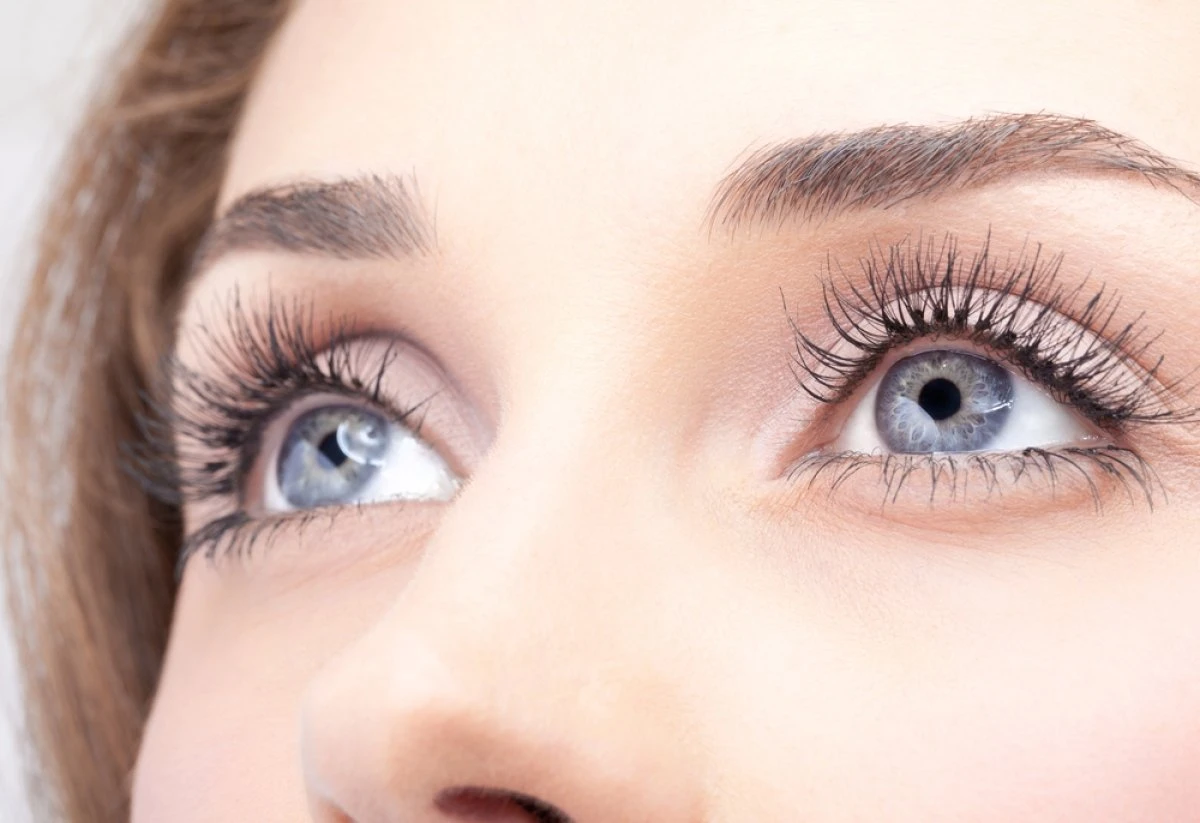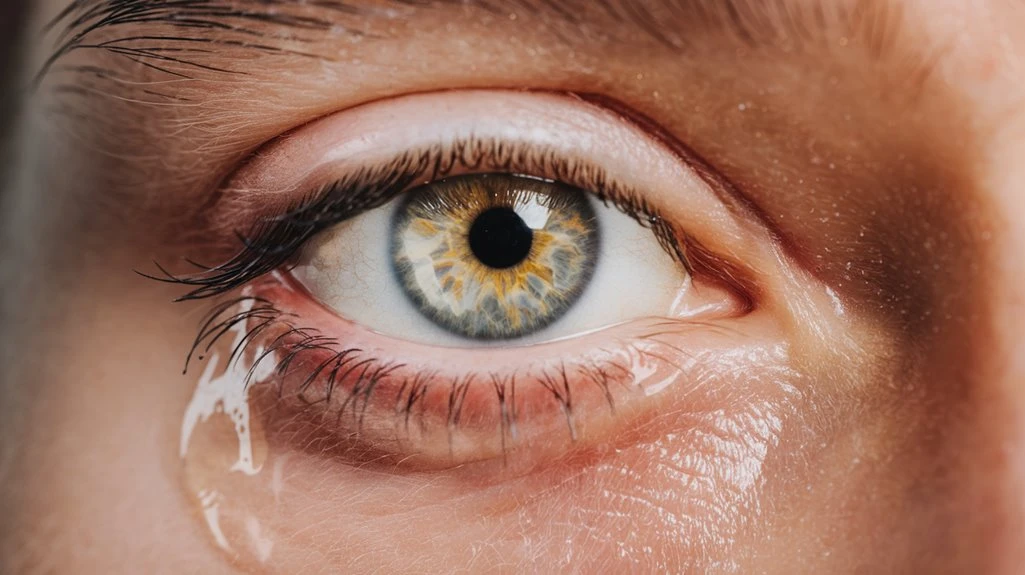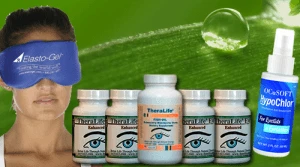Your eyes may water constantly due to various causes, and understanding these factors involves an evidence-based approach to identify and manage the symptoms effectively. TheraLife offers a range of products designed to alleviate these issues by addressing the underlying causes.
For instance, TheraLife’s products are beneficial for those suffering from dry eye syndrome, often aggravated by aging, offering relief through natural supplements that enhance tear production. These products also help manage allergic reactions to pollen and dust, which trigger histamine release and cause tearing, by using anti-inflammatory properties.
In cases of blocked tear ducts and eyelid disorders, TheraLife provides solutions that promote healthy tear drainage and address structural anomalies. Their products also combat environmental irritants, such as pollution or wind, which further exacerbate tearing.
TheraLife’s offerings extend to those dealing with autoimmune disorders like Sjögren’s syndrome, providing dietary supplements that support immune health and reduce symptoms. For neurological conditions that lead to excess tears through enhanced lacrimal gland activity, TheraLife offers targeted therapies that regulate tear production.
By exploring how each of these elements contributes uniquely to constant eye-watering, TheraLife empowers customers with products that are grounded in scientific research and tailored to individual needs, offering a comprehensive approach to eye health.
Powerful Treatment To Stop Watery Eyes – TheraLIfe. When Drops Don’t Work
Root cause of watery eyes is chronic dry eyes. Treat chronic dry eyes with oral treatment from TheraLIfe.
Complete oral solution for watery dry eyes treatment blepharitis/MGD
Key Takeaways
- Dry eye syndrome triggers reflex tearing due to eye dryness and imbalance in tear film.
- Allergic reactions to pollen or dust cause watery eyes as tears flush out allergens.
- Environmental irritants like pollution and wind increase tear production to protect the eyes.
- Structural anomalies such as blocked tear ducts or eyelid disorders disrupt normal tear drainage.
- Autoimmune conditions and neurological disorders can lead to excessive tearing due to inflammation and impaired tear mechanisms.
Dry Eye Syndrome
Although it might seem counterintuitive, dry eye syndrome can actually lead to constantly watery eyes due to reflex tearing. This paradox occurs because your eyes, sensing dryness, overproduce tears. Treatment options focus on restoring the tear film balance and providing symptom relief. Artificial tears are a primary intervention, rehydrating the ocular surface. For persistent cases, topical anti-inflammatory medications may be necessary to manage inflammation. Lifestyle modifications, like limiting screen time and improving air quality, can also enhance symptom relief. In severe instances, surgical procedures such as punctal plugs might be recommended to conserve natural tears. Addressing environmental factors, like increasing humidity, can further support tear film stability and reduce the reflex tearing that causes excessive watering. Aging is a significant risk factor for dry eye syndrome, contributing to changes in the tear film that exacerbate symptoms. Chronic dry eyes can also lead to complications such as blepharitis and meibomian gland dysfunction, further aggravating the condition and increasing discomfort.
Allergic Reactions
When exposed to allergens like pollen, dust, and pet dander, your body mounts an immune response that can result in watery eyes. This occurs due to the histamine response, where histamines are released, causing swelling of the eyelids and conjunctiva, accompanied by redness and itching. Your eyes produce tears as a defense mechanism to flush out these allergens. Common allergens include pollen from trees, grasses, and weeds, as well as indoor triggers like dust mites and mold spores. Flonase is recommended for comprehensive relief of nasal and eye allergy symptoms, providing a solution for those struggling during allergy season. These can cause conditions such as Seasonal Allergic Conjunctivitis (SAC) or Perennial Allergic Conjunctivitis (PAC). Allergy testing can pinpoint specific allergens affecting you, allowing for targeted treatment. Over-the-counter antihistamines or prescription medications may offer relief, but consult a doctor if symptoms persist. In addition, maintaining good eye health through regular check-ups and proper hygiene can help prevent complications associated with eye allergies and infections.
Blocked Tear Ducts
Beyond allergens, another common cause of constantly watery eyes is blocked tear ducts. The blocked tear duct causes can range from congenital conditions to trauma or tumors. Diagnosis involves a detailed ophthalmic examination and might include imaging like a dacryocystogram. Symptoms such as excessive tearing, redness, and painful swelling suggest a blockage. It is worth noting that meibomian gland dysfunction, which is linked to conditions like chalazion and dry eye, can also exacerbate tear duct blockages. A blocked tear duct diagnosis is confirmed through specific tests evaluating tear drainage. Prompt treatment of eye inflammation or infections is crucial in preventing complications associated with blocked tear ducts.
Eyelid Disorders
Eyelid disorders can greatly contribute to the problem of constantly watery eyes, causing both discomfort and potential complications. Conditions like ectropion lead to corneal exposure due to the eyelid turning outward, resulting in excessive tearing. Entropion, where the eyelid turns inward, causes entropion irritation as eyelashes scrape the cornea, prompting tear overproduction. Recognize the ptosis impact when drooping eyelids disrupt normal tear drainage pathways, exacerbating watery eyes. Dermatochalasis, with its baggy skin, also hampers tear drainage, leading to fluid retention. Trichiasis complications arise from ingrown eyelashes irritating the eye, causing continuous tearing. Eyelash mites, such as those from the Demodex species, can also lead to eyelid irritation and inflammation, contributing to watery eyes. It is important to consult an oculofacial plastic surgeon for evaluation, as early intervention can prevent complications associated with epiphora.
- Ectropion effects: Outward-turned eyelid
- Entropion irritation: Inward-turned eyelid
- Ptosis impact: Drooping eyelid
- Dermatochalasis causes: Baggy skin
- Trichiasis complications: Ingrown eyelashes
Environmental Irritants
Environmental irritants play a significant role in causing watery eyes, with various factors contributing to this condition.
Air pollution, laden with particulate matter and smoke, irritates the ocular surface, leading to increased tear production. Exposure to airborne allergens like pollen can trigger allergic conjunctivitis, exacerbating tear secretion. Weather extremes, such as intense heat or cold, also compromise the tear film, resulting in both dryness and excessive tearing. Windy conditions further aggravate this by accelerating tear evaporation. Older adults may suffer from eyelid malposition, such as entropion and ectropion, which can disrupt normal tear flow and contribute to excessive tearing. Dry climates and low indoor humidity can dehydrate the eyes, prompting a compensatory increase in tear flow. Using protective eyewear can help shield the eyes from these environmental irritants, reducing the need for compensatory tear production.
These environmental factors create a challenging scenario, where the eyes overproduce tears to counteract irritation and dryness, highlighting the need for protective measures against such irritants.
Structural Eye Issues
Structural eye issues also contribute considerably to the problem of watery eyes. Tear duct blockages are a primary reason, as they hinder tear drainage, resulting in excess tearing. Blockages can arise from congenital obstructions, trauma, infections, or inflammation. Additionally, dry eyes are a common cause of excess tearing, as dryness causes discomfort, leading to increased tear production. Lacrimal gland issues, such as overproduction of tears or lacrimal pump failure, can exacerbate this condition. Eyelid disorders like blepharitis or ectropion further impair tear drainage, causing persistent watering. In some cases, conditions like Meibomian gland dysfunction can complicate matters by affecting oil secretion, thus destabilizing the tear film and contributing to increased tearing. Diagnosis often involves a physical examination and diagnostic imaging to assess these structural anomalies. Treatment ranges from surgical interventions like dacryocystorhinostomy to address blockages, to managing underlying eyelid conditions.
- Tear duct obstructions: Prevent proper tear drainage.
- Lacrimal gland overactivity: Produces excess tears.
- Eyelid malpositions: Affect tear drainage.
- Nasolacrimal duct issues: Block tear flow.
- Corneal irritation: Stimulates tear production.
Systemic Health Conditions
While structural anomalies in the eye can certainly lead to excessive tearing, systemic health conditions often play a significant role in this issue as well. Autoimmune diseases such as Sjögren’s Syndrome and Rheumatoid Arthritis cause dry eyes by damaging the lacrimal glands, prompting reflex hypersecretion. Similarly, Systemic Lupus Erythematosus and Sarcoidosis can lead to inflammation and obstruction, affecting tear balance. Thyroid Eye Disease may also disrupt normal lacrimal duct function. Neurological disorders, including Parkinson’s Disease and Trigeminal Neuralgia, can lead to impaired motor function and ocular surface irritation, triggering excessive tear production. Neurological inflammation further exacerbates lacrimal gland activity. An autoimmune diet can help mitigate symptoms of these systemic conditions by reducing gut inflammation. Understanding how dry eyes can lead to excessive tearing is crucial in identifying the body’s reflex response to irritation. Always consult a healthcare professional for personalized evaluation.
Powerful Treatment To Stop Watery Eyes – TheraLIfe. When Drops Don’t Work
Root cause of watery eyes is chronic dry eyes. Treat chronic dry eyes with oral treatment from TheraLIfe.
Complete oral solution for watery dry eyes treatment blepharitis/MGD
Frequently Asked Questions
Can Certain Foods Cause My Eyes to Water?
Yes, certain foods can cause your eyes to water.
Spicy foods like chili peppers contain capsaicin, which stimulates the mucus membranes, causing tear production.
Citrus fruits, rich in vitamin C, can also trigger watery eyes in sensitive individuals due to their acidic nature.
Evidence shows that these foods can irritate your eyes, leading to excess tearing.
It’s important to monitor your diet and identify any specific triggers that might affect you.
How Does Excessive Screen Time Affect Tear Production?
Excessive screen time greatly impacts tear production. You experience reduced blinking, leading to rapid tear evaporation and digital eye strain.
Prolonged exposure to screens, especially to blue light, exacerbates strain, causing discomfort and potentially dry eye syndrome. Evidence shows that working on screens for extended periods can reduce tear distribution, doubling the risk of dry eye disease.
Implementing preventive strategies, like the 20-20-20 rule, can alleviate these symptoms effectively.
Are There Specific Exercises to Help Reduce Watery Eyes?
To reduce watery eyes, incorporate eye relaxation and lid exercises.
Practice blinking every 5 seconds to maintain moisture and reduce tear overproduction. The 20-20-20 rule helps alleviate strain by shifting focus.
Palming relaxes ocular muscles, enhancing moisture. Use the Figure Eight exercise to boost muscle flexibility and coordination.
These techniques are evidence-based and improve eye health, minimizing discomfort and promoting ideal tear film stability for better visual acuity.
Can Dehydration Lead to Increased Tear Production?
Imagine your eyes producing up to 30% more tears due to dehydration symptoms.
When you’re dehydrated, the tear composition changes, becoming imbalanced. This imbalance can irritate your eyes’ surface, causing reflex tearing as your body attempts to compensate.
Dehydration leads to less aqueous humor, an essential part of your tear film, resulting in dryness that paradoxically triggers excessive tearing.
Maintaining proper hydration is vital to stabilize tear production and prevent discomfort.
Does Stress or Anxiety Contribute to Watery Eyes?
You might notice your eyes watering due to stress factors and anxiety symptoms.
Stress triggers physiological changes, including altered tear production. When you’re stressed, your body might respond with dry eyes, prompting reflex tearing to counteract dryness, resulting in watery eyes.
Anxiety amplifies this by increasing inflammation and sensitivity.
Evidence shows managing stress through relaxation techniques can help. Addressing underlying stress factors can stabilize tear production, alleviating excessive tearing effectively.
Powerful Treatment To Stop Watery Eyes – TheraLIfe. When Drops Don’t Work
Root cause of watery eyes is chronic dry eyes. Treat chronic dry eyes with oral treatment from TheraLIfe.
Complete oral solution for watery dry eyes treatment blepharitis/MGD
Conclusion
Discover how TheraLife’s innovative products can alleviate your constant eye watering by addressing the root causes. Whether it’s combating Dry Eye Syndrome, managing allergens, or dealing with blocked tear ducts, TheraLife offers a range of solutions designed to restore comfort and clarity. Their comprehensive approach includes natural treatments for blepharitis, uveitis, and other systemic health conditions that might contribute to your symptoms.
TheraLife’s products are crafted with natural ingredients to soothe eye irritations and provide relief from environmental irritants and structural issues. With their Eye Enhanced formula, you can tackle dryness, while their targeted treatments for conditions like Sjögren’s Syndrome and rheumatoid arthritis ensure holistic care. Embrace the empowerment that comes with understanding and addressing your eye health concerns confidently, thanks to TheraLife’s expert guidance and effective solutions.





